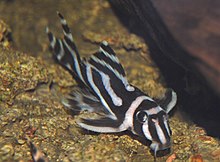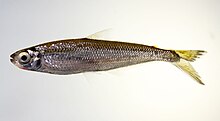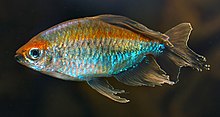Tetras
| Tetras | ||||||||||||
|---|---|---|---|---|---|---|---|---|---|---|---|---|

Pristella maxillaris ( Pristella maxillary ) |
||||||||||||
| Systematics | ||||||||||||
|
||||||||||||
| Scientific name | ||||||||||||
| Characiformes | ||||||||||||
| Goodrich , 1909 |
The tetras (Characiformes), also called tetras or tetra fish , are an order of bony fish . It includes more than 2200 species, u. a. the piranhas and neon tetra . Some species are used as food fish , and many species are popular freshwater ornamental fish because of their brilliant colors .
distribution
The tetra are mainly found in tropical lakes and rivers in South America , Central America and in Africa south of the Sahara as well as in the Nile . With just over 230 species, only a small part of the total number of species lives in Africa. In America, the area extends in the north to Texas, in the south west of the Andes to Isla del Chiloé (Chile) and east of the Andes to Arroyo Valcheta in the province of Río Negro. In the Andes, individual species are found at altitudes over 3000 m.
All tetra are strict freshwater inhabitants and already avoid brackish water. This in connection with their occurrence in America and Africa suggests that they have already diversified into their main lineages during the Cretaceous Period .
features
The order of the tetra is diverse, but most species are barbel-like in shape, eel-like elongated shapes or flattened bottom dwellers are missing. The tetras of America have produced more diverse body shapes than the African tetras. Like all Ostariophysi , the tetra-like are characterized in particular by Weber's apparatus , which is simply built here, and a series of bony structures between the swim bladder and the inner ear. Most Characiformes are characterized by a small adipose fin between the dorsal fin and caudal fin and strong teeth. The teeth in the upper jaw usually lie on the premaxillary . The maxillary is usually not or only weakly dentate. Furthermore, the pterygoid and palatine can be dentate. The jaw teeth are multi-pointed. The Breitling tetras (Curimatidae) lack teeth with age. The upper jaw cannot be pulled forward completely, exceptions are the club tetra (Hemiodontidae) and the barbel tetra (Prochilodontidae). Mouth teeth are usually present, but only in the narrow-mouthed tetra (Anostomidae) specialized in a similar way as in the carp- like species (Cypriniformes). There are no barbels , the number of Branchiostegal rays is three to five.
The body is usually covered with round scales, comb scales or scales similar to comb scales occur only in the straight tetras and a few species of the Characoidei. The head is bare. Even on the body without any scales, there are only full-grown representatives of the species Gymnocharacinus bergii , which lives in Patagonia and which also has no adipose fin. The pelvic fins are supported by five to twelve fin rays, the caudal fin usually has 19 main fin rays. The anal fin is short or moderately long, with fewer than 45 rays. All fin rays are soft rays. In the males, the rays of the anal and pelvic fins can have small hooks. The first hypuralia is separated from the vertebral body by a gap . Most of the other lower teleostei lack such a loophole . The sideline is sometimes incomplete. Tetra-like are physostomes , the two-part swim bladder is connected to the intestine. It serves some predatory tetras ( Erythrinus & Hoplerythrinus ) as well as some slim tetra of the genus Lebiasina as an additional respiratory organ.
Many tetra are very colorful, many also silvery. The largest species is the 1.40 meter long Hydrocynus goliath from the Congo . Some species stay under three centimeters in length, the smallest becomes 13 mm long.
Way of life
Many tetra species are referred to as schooling fish in the literature . Most tetra species known as schooling fish only show real schooling behavior when an alleged danger occurs. Without this external influence, the swarm formation is abandoned in favor of a loose group association with a certain individual distance. In the process, small areas can be formed temporarily, which are demarcated and defended by a ritualized fighting behavior similar to that of cichlids . This and also the hierarchy that is occasionally observed require that members know each other individually, which does not correspond to the behavioral definition of real schooling fish . One of the few real schooling fish among the tetras is the redhead tetra ( Hemigrammus bleheri ).
Tetras feed as carnivores, omnivores or herbivores. The carnivores include piranhas that live in larger groups , as well as elongated predatory fish such as the spindle tetra and predatory tetra , the American and African pike tetra . The wimple piranha ( Catoprion mento ) Gnathodolus bidens and Probolodus heterostomus are shed eaters. The Distichodontidae genera Belonophago, Eugnathichthys, Ichthyborus & PHAGO feed mainly on the fins of other fish. The herbivores include the Black Pacu , the Metynnis and the Myleus species. Only a few tetra practice brood care , the spawn is mostly deposited in plants. Some tetra species can communicate with each other acoustically, with sounds produced by the swim bladder, which is vibrated with the help of drum muscles. The chorus-like sounds of the Prochilodus can also be heard outside the water and are used by local fishermen to locate the schools.

External system
The tetras belong to the Ostariophysi , which also include the carp-like (Cypriniformes) and the catfish-like (Siluriformes). They stand alone in the superorder Characiphysae and are the sister group of the Siluriphysae (catfish-like and New World knife fish ). Their phylogenetic relationships are shown in the following cladogram :
| Otomorpha |
|
||||||||||||||||||||||||||||||||||||
|
|
Internal system
There are more than 2200 species in approx. 270 genera, 25 families and two suborders:



- Suborder Geradsalmler (Citharinoidei), Africa.
- Family Geradsalmler (Citharinidae)
- Family Distichodontidae
- Suborder Characoidei, Africa, South and Central America.
- Family tetra and ground tetra (Crenuchidae)
- Subfamily Prachtsalmler (Crenuchinae)
- Subfamily Bodensalmler (Characidiinae)
- African tetra family (Alestidae)
- African pike tetra family (Hepsetidae)
- Superfamily Erythrinoidea
- Raubsalmler family (Erythrinidae)
- Family Tarumaniidae
- Algae tetra family (Parodontidae)
- Wolfsalmler family (Cynodontidae)
- Club tetra family (Hemiodontidae)
- Sägesalmler family (Serrasalmidae)
- Superfamily Anostomoidea
- Engmaulsalmler family (Anostomidae)
- Family headstanders (Chilodontidae)
- Breitling tetras family (Curimatidae)
- Barbensalmler family (Prochilodontidae)
- American pike tetra family (Ctenoluciidae)
- Family Schlanksalmler (Lebiasinidae)
- Family Chalceidae
- Family Acestrorhynchidae
- Subfamily Acestrorhynchinae
- Subfamily Roestinae
- Subfamily Heterocharacinae
- Family Iguanodectidae
- Family Bryconidae
- Family hatchet tetra (Gasteropelecidae)
- Family Triportheidae
- Subfamily Triportheinae
- Subfamily Agoniatinae
- Subfamily Clupeacharacinae
- Family tetras (Characidae)
- Family tetra and ground tetra (Crenuchidae)
The following cladogram shows the likely family relationships :
| Characiformes |
|
|||||||||||||||||||||||||||||||||||||||||||||||||||||||||||||||||||||||||||||||||||||||||||||||||||||||||||||||||||||||||||||||||||||||||||||
|
|
At the beginning of 2017, it was questioned whether the tetra is actually a monophylum, i.e. a systematic unit that contains the last common ancestor and all of his descendants. According to a study published in February 2017, the suborder Characoidei is the sister group of the catfish-like (Siluriformes), i.e. more closely related to them than to the suborder Citharinoidei. The latter is the sister group of the clade formed by Characoidei and Siluriformes . However, the results of this study were contradicted shortly thereafter by other sources.
Fossil record
The oldest fossil of a tetra-like fish comes from the Albium, the chronostratigraphically highest level in the Lower Cretaceous . Santanichthys from Brazil was likely marine or lived in brackish water and is probably the oldest tetra or otophysian . Further fossil tetra species are Sorbincharax from the extinct family Sorbincharacidae, Paleohoplias and Tiupampichthys from South America, Eocitharinus , possibly a representative of the African suborder Citharinoidei and Mahengecharax , possibly the sister species of Alestidae. The recent genus Brycon is known from the Oligocene , Tetragonopterus and Triportheus since the Miocene .
literature
- Kurt Fiedler: Textbook of Special Zoology (2nd volume, 2nd part: fish) . Gustav Fischer Verlag., Jena 1991, ISBN 3-334-00339-6 .
- Joseph S. Nelson : Fishes of the World . John Wiley & Sons, 2006, ISBN 0-471-25031-7 .
- Günther Sterba : The world's freshwater fish. 2nd Edition. Urania, Leipzig / Jena / Berlin 1990, ISBN 3-332-00109-4 .
- Petru Banaescu: Zoogeography of Fresh Waters . Aula Verlag., Wiesbaden 1990, ISBN 3-89104-480-1 .
Individual evidence
- ^ Fricke, Eschmeyer & Fong: Eschmeyer's Catalog of Fishes. Retrieved July 24, 2020 .
- ↑ Campos et al .: Presencia de Cheirodon australe (Pisces: Characidae) en Lago Tarahuín (Isla Grande de Chiloé, 42º40'S, Chile) y su Significado Zoogeográfico. Medio Ambiente 1996 13 (1): 69-79.
- ^ Wolfgang Staeck: Tetra from South America. Verlag Dähne 2008, ISBN 3-935175-41-8 , pp. 53-56
- ↑ Betancur-R, R., Wiley, EO, Arratia, G. et al. Phylogenetic classification of bony fishes. BMC Evol Biol 17, 162 (2017). https://doi.org/10.1186/s12862-017-0958-3
- ↑ Claudio Oliveira et al .: Phylogenetic relationships within the speciose family Characidae (Teleostei: Ostariophysi: Characiformes) based on multilocus analysis and extensive ingroup sampling. BMC Evolutionary Biology 2011, 11: 275 doi : 10.1186 / 1471-2148-11-275
- ↑ a b Mário de Pinna, Jansen Zuanon, Lucia Rapp Py-Daniel, Paulo Petry (2017): A new family of neotropical freshwater fishes from deep fossorial Amazonian habitat, with a reappraisal of morphological characiform phylogeny (Teleostei: Ostariophysi). Zoological Journal of the Linnean Society , XX: 1-31. doi: 10.1093 / zoolinnean / zlx028
- ↑ Mirande, JM (2018): Morphology, molecules and the phylogeny of Characidae (Teleostei, Characiformes). Cladistics, June 2018. doi: 10.1111 / cla.12345
- Jump up ↑ Prosanta Chakrabarty, Brant C. Faircloth, Fernando Alda, William B. Ludt, Caleb D. McMahan, Thomas J. Near, Alex Dornburg, James S. Albert, Jairo Arroyave, Melanie LJ Stiassny, Laurie Sorenson, Michael E. Alfaro: Phylogenomic Systematics of Ostariophysan fishes: Ultraconserved Elements Support the Surprising Non-monophyly of Characiformes. Systematic Biology, Volume 66, Issue 6, 1 November 2017, Pages 881–895, DOI: 10.1093 / sysbio / syx038
- ↑ Betancur ‐ R., R., D. Arcila, RP Vari, LC Hughes, C. Oliveira, MH Sabaj and G. Ortí 2019: Phylogenomic incongruence, hypothesis testing, and taxonomic sampling: The monophyly of characiform fishes. Evolution, 73: 329-345. doi: 10.1111 / evo.13649
- ^ KA Frickhinger: Fossil Atlas Fish , Mergus-Verlag, Melle, 1999, ISBN 3-88244-018-X
Web links
- Tetrao on Fishbase.org (English)
- Tree of Life Web Project - Characiformes. Tetras, piranhas, hatchetfishes, headstanders, pencilfishes, and their relatives.
- Tetra overview

